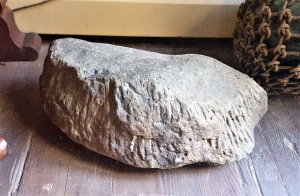National Fossil Day
The Catskill Geologists; The Mountain Eagle
Robert and Johanna Titus
Oct. 19, 2018
An event of some importance to the two of us is coming up soon. That’s National Fossil Day. That’s Wednesday, Oct. 17th. It is primarily sponsored by the National Park Service, but it is also co-sponsored by about 270 other groups. The purpose is to “promote the scientific and educational value of fossils.” Hundreds of events are scheduled all across the country.
Let’s make you and “The Catskill Geologists” into group number 271. We have pondered what would be the most significant Catskills fossil and the choice was obvious. Our pick is something, a fossil plant, called a pseudosporochnalean cladoxylopsid. It’s also known to scientists as Eospermatopteris.” Those words are jawbreakers and so it won’t surprise you to find out that the plant is commonly referred to as “the Gilboa tree.”

The Gilboa tree was, of course, first discovered in Gilboa. That was back in the nineteenth century, but many more were found during excavations associated with the building of the Gilboa dam in the 1920’s. Those discoveries were of the stumps of about 200 trees. They were immediately recognized as being some of the most primitive trees known to science and their discovery generated a lot of excitement. Unfortunately, only the stumps were found. Those trees had apparently been growing along the banks of Devonian aged streams on something called the Catskill Delta. Floods deposited sands which buried and preserved those stumps. The middle and upper reaches of the trees were not buried and subsequently those parts decayed away. That was during the Devonian time period, about 380 million years ago.
What kind of tree, exactly, was the Gilboa fossil? Without any preserved foliage from the upper tree, nobody could tell. For about 80 years or so, this was one of the big mysteries of paleontology. Everybody understood that they were among the earliest and most primitive trees. Everybody also understood that an important discovery was needed. If good foliage was found then, it was argued, we could determine just exactly what our planet’s earliest trees were.
That discovery came in an eastern Catskills quarry just years ago. Researchers from the New York State Museum were conducting a routine survey of the area when they stumbled across fossil foliage on a horizon of rock at the bottom of the quarry. The discovery was a bit of a disappointment because the foliage was so exotic and so primitive that we still don’t really know what kind of tree it is.
We would like it if you celebrated National Fossil Day by training your eyes to be alert for fossils in the rocks that you routinely pass by. Gilboa forest fossils are out there. But, we think it highly unlikely that you will encounter the foliage. So, let’s talk about what you might find on a good day—a very good day. And that discovery would be one of those tree stumps. We found one about 20 years ago and we include a photograph of it.
This seems to us, to be a very primitive stump. It lacks the sort of extensive root system that modern trees have. We look at it and are reminded of the bottoms of the stems of many mushrooms. How could this primitive tree have stood tall on windy days? We don’t know.
Well, take a good look and keep this image in mind. If you enjoy walking along Catskills streams, or through Catskills quarries, then you just might spot one of these. If you do, please send us a photo.
==================================================================
Contact the authors at randjtitus@prodigy.net. Join their facebook page “The Catskill Geologist.” Read their blogs at “thecatskillgeologist.com.”





